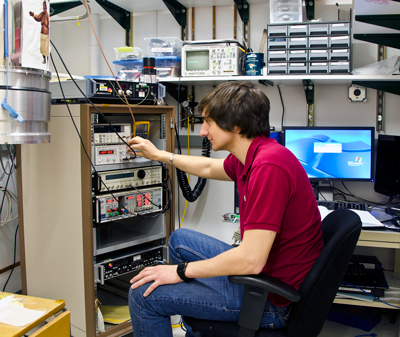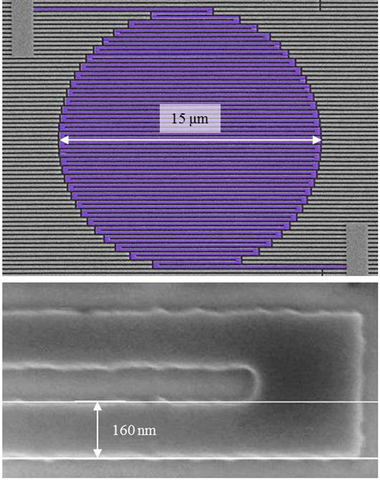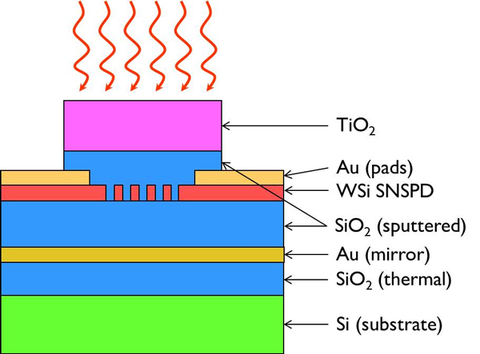
Francesco Marsili at the SPD experiment. The metal cylinder at top left is the device's cryogenic enclosure.
A single photon may not seem like much of a catch. But detecting photons one-by-one with near-perfect reliability is formidably difficult. It is also an extremely important research goal, not only in fiber-based telecommunications, but in numerous other fields from quantum information science and data-encryption to medical imaging, light detection and ranging, DNA sequencing, astrophysics, and materials science.
Now scientists from the Optoelectronic Manufacturing Group of PML's Quantum Electronics and Photonics Division have made substantial progress toward that goal by devising and improving a novel single-photon detector (SPD) system which can satisfy all four of the stringent criteria for an optimal detector.
Whatever its method of operation – and there are more than half a dozen alternate configurations for SPDs, each with different advantages and disadvantages – an ideal device would have
- A 100% detection efficiency – the probability that a photon is successfully detected every time it hits the detector;
- A zero rate of "dark counts" – instances in which the detector registers a photon when none is there;
- A zero reset or "dead time" – the interval after a detection during which the device cannot detect a new photon; and
- A zero "timing jitter" – uncertainty in specifying when a photon arrives.
"That's the theoretical ideal," says Francesco Marsili, first author on the project's newest paper, an Advance Online Publication in Nature Photonics. "In practical terms, that means at least 90% detection efficiency, fewer than 100 dark counts per second, a jitter below 100 picoseconds, and a reset time that should be below 100 nanoseconds, and ideally below 10 ns. Our new system more or less satisfies all of those parameters."
The design relies on a host of innovations in materials and packaging, resulting in a sensor measuring 12 µm by 12 µm and a system that can reach 93% overall detection efficiency. That's a record for such devices. Not surprisingly, it was several years in the making.

"TES systems have very high detection efficiency, around 98 percent," Marsili says, "but the problem is that they're very slow. Their reset time is on the order of a microsecond and they typically have tens of nanoseconds of jitter. Taken together, that's inadequate performance because most experiments are clocked at around 80 megahertz," a frequency determined by the repetition rate of the pulsed laser that provides the photons.
So about four years ago, the project began exploring a related system with tiny dimensions but an expansive name: superconducting nanowire single-photon detector (SNSPD or nSSPD). This design incorporates nanowires made of a superconducting film that is approximately 4 nm to 6 nm thick, and 100 nm to 200 nm wide. The wire is cooled to less than 2 K and biased with a current precisely set to just below the critical threshold at which the material switches to a normal conductor. When a photon strikes one such wire, it forms a "hot spot" at which superconductivity is lost, diverting current through other sections of the wire. That current now exceeds the critical limit, and all the material loses its superconductivity. The current, suddenly encountering large resistance, flows into a lower-resistance shunt circuit where its voltage pulse is recorded, providing the photon-detection signal.

"The tungsten compound, on the other hand, can be deposited cold, is robust in the face of structural defects, and is more uniform across the whole active area of the detectors. Those characteristics give us more degrees of freedom in design."
Subsequent improvements – including a three-dimensional configuration with two meanders in a vertical stack at right angles to one another – boosted peak system detection efficiency to around 87%, doubled the signal-to-noise ratio, and made the device independent of the polarization of the incident photon. In December 2012, project scientists reported that work in Applied Physics Letters.
"The idea of stacking orthogonal nanowire meanders to eliminate polarization dependence is a relatively simple idea," says project member Varun Verma. "However, before WSi devices, it seemed very difficult if not impossible to do this due to the crystalline nature of NbN. The stacked nanowires would require some kind of electrical insulator in between them, and it wasn't clear that NbN could be deposited on top of an insulator and still maintain its superconducting properties. After we started working with WSi, Sae Woo brought up the idea of trying the stacked design with meanders connected in parallel to improve signal-to-noise ratio, as Francesco had shown in previous work in NbN at MIT. My contribution was then to figure out how to fabricate the detectors in our cleanroom here at NIST. So the 3D detector really evolved from the collaborative efforts of all three of us having different areas of expertise."
For the new Nature Photonics paper, produced in collaboration with researchers at the Jet Propulsion Laboratory at Caltech, the group tested 28 different SNSPDs from five different fabrication runs in which about 80 devices were integrated on a single wafer. The best units had a system detection efficiency of 93%.
Many challenges remain before the system is optimized. One of the most pressing: The researchers would like to operate the detector continuously below 1 K, where it performs best. That will require an innovative cooling system. "Right now," Marsili says, "we are trying to figure out, given current cryotechnology, how to make the refrigeration system as portable as possible." But the group is optimistic.
"WSi is an exciting area of research because we have been able to obtain detectors with a detection efficiency that has not been possible after ten-plus years of work on NbN by experts around the world," says project leader Sae Woo Nam. "The detection efficiency easily exceeds what has been possible in NbN. It also appears that this material is much more tolerable to imperfections in the fabrication process, so that we can envision making large arrays or cameras. We also believe we will soon be able to detect single photons at mid-infrared range (with wavelengths of 2 µm to 5 µm) with very few, if any, dark counts. I don't know of any other single photon detector that will have this capability."
* The first SNSPD was developed in 2001 by physicists at the State Pedagogical University of Moscow and University of Rochester using niobium nitride.

